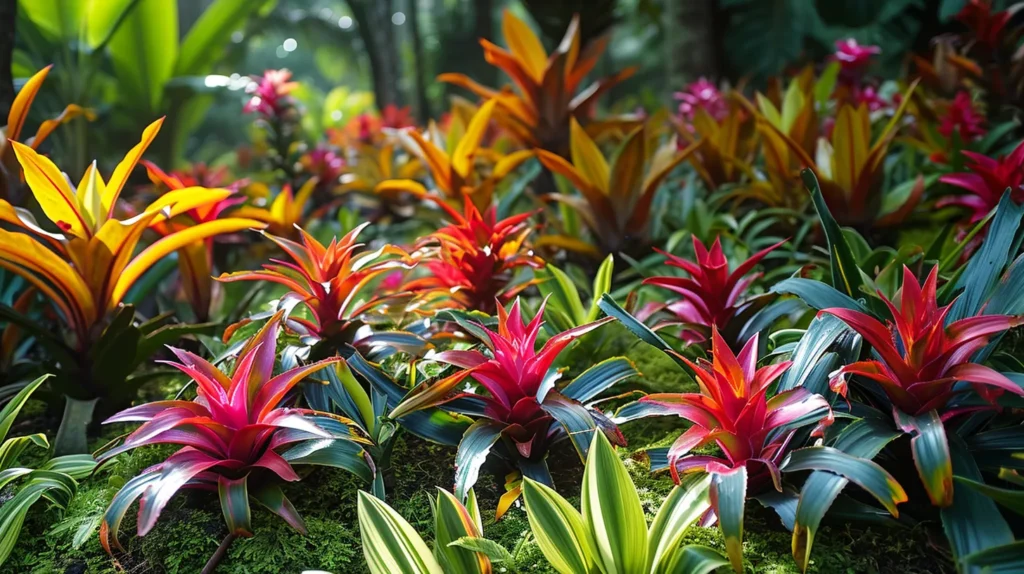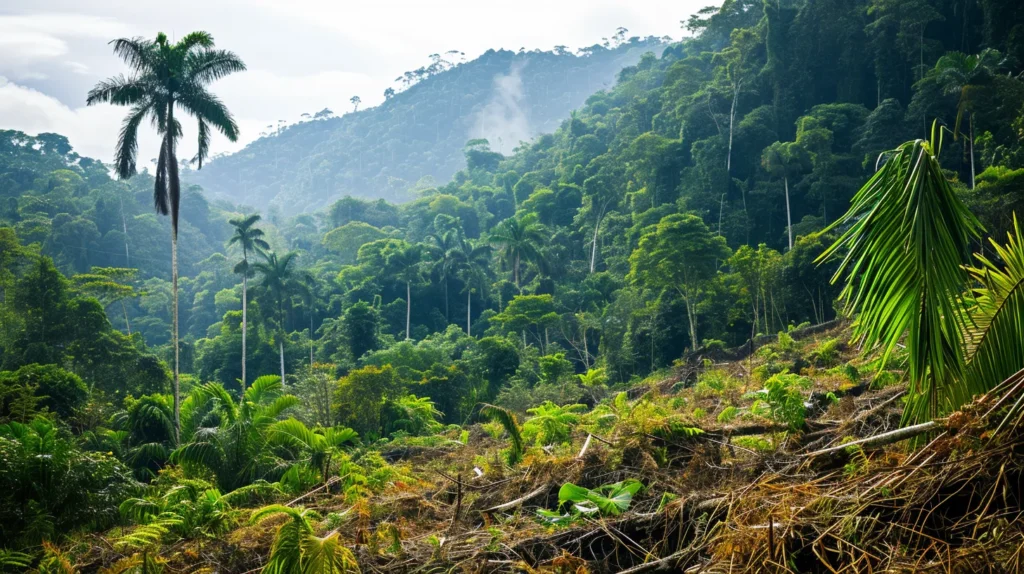
These tropical rainforests are more than the “lungs” of Earth. They are full of the most fascinating plants anywhere.
We will look at 10 Tropical Rainforest Plants Common in South America. Each has its own beauty and role in this complex system.
The Giant Water Lily has enormous leaves. The Passion Flower has intricate beauty. These show nature’s creativity.
We will also discuss climate issues and conservation. These help to preserve the rainforests.
Here, every leaf and plant tells a story.
They help us understand the environment better. This goes for botanists, eco-fans, and the curious.
Get ready to be amazed by the many plants. They grow in South America’s rainforest heart.
You will learn new things and be inspired. This may move you to take action.
We explore the green worlds that have such variety. Let’s look at 10 common rainforest plants. Discover what awaits under that canopy!
The Rich Tapestry of Rainforest Biodiversity

Seeing the Tropical Rainforest’s Riches
The rainforest has more than trees. It is a complex place with much variety.
The dense treetops filter light. This canopy forms a green roof.
Under this leafy roof is the understory. Here, plants get less sunlight.
On the floor are nutrients and dampness. Here, all soil teems with life.
South America’s Vital Rainforests
South America’s tropical rainforests have unmatched variety. They have many unique plants and animals.
These forests help balance the climate. They take in carbon dioxide. They put out oxygen.
They also provide medicines and resources. But they face many threats now.
We can help by understanding them. Next, we’ll see rainforest plants. First is the giant water lily.
A Closer Look at South America’s Tropical Rainforest Flora
1. The Giant Water Lily – Nature’s Floating Marvel

The Giant Water Lily (Victoria amazonica) has enormous lily pads. They can grow over 9 feet wide to hold a child.
Native to the Amazon basin, it is unique. It uses temperature to bring pollinators.
The Lily symbolizes tropical grandeur. It also gives rainforest wildlife a home.
2. Heliconia Latispatha – The Rainforest’s Bright Flag

Image by Stefan Schweihofer from Pixabay
The Heliconia, often called the “Lobster Claw,” has bright red and orange bracts. These attract hummingbirds that pollinate it.
It represents the rainforest’s understory layer. Here is warmth and moisture under trees.
3. Coffea Arabica – From Rainforest to Coffee Cup

Coffea arabica makes most coffee worldwide. It began in Ethiopian rainforest understories.
In South America, it thrives too. It shelters rainforest life while giving us economy.
4. Hevea Brasiliensis – The Latex Producer

Rubber trees have sap used for centuries. This drove the rubber boom in the late 1800s.
Although substitutes exist, they still help rainforests. It has economic and ecological benefits.
5. Combretum Rotundifolium – The Rainforest Vine

Monkey Brush Vine has fiery red rainforest flowers. It feeds insects and birds in the food web.
It is a vital part of the complex ecology. It climbs through the green backdrop.
6. Passion Fruit Flower – The Edible Ornament

The passion fruit vine has ornamental and edible flowers. Their intricate blooms attract pollinators to filaments and petals.
In South America, they admire its looks and fruit. The sweet, tangy passion fruit is used in cuisines and exports.
Passion Flowers’ Rainforest Variations
Over 500 passion flower species live in rainforests. They have climbing tendrils and diverse flower shapes.
Their creative adaptations show the dynamics here. These plants thrive in this environment.
7. The Enigmatic Dutch Amaryllis

The Dutch Amaryllis (Hippeastrum) has big, colorful trumpet flowers. Although named after Holland, it began in South America.
It grows in rainforest understories. There, it adds splashy colors amid green.
8. The Strangler Fig – Rainforest’s Architect

The Strangler Fig starts high in the canopy. Its seeds come from animals above.
It sends roots down, enveloping and killing its host tree. This shapes the habitat for creatures.
9. Carnivorous Plants – The Rainforest Predators

Some rainforest plants eat insects and animals. Heliamphora pitcher leaves hold digestive liquid.
They evolved to get nutrients from poor soils. These fascinating adapters show the diversity here.
10. Canopy Layer Plants – The Sunbathers

The rainforest canopy gets the most sun. Here, leaves conduct photosynthesis.
Heliconia flowers thrive in dappled light. Bromelias form homes for creatures.
Understory Layer Plants – Thriving in Shadows
The understory is dim and humid. Plants like Monkey Brush Vines grow here.
With less light, plants have enormous leaves for the sun. Orchids and ferns partner for nutrients.
The Impact of Climate Change on Tropical Rainforest Plants

Climate Change Challenges in South America
Climate change threatens South America’s rainforests. Rising heat, shifting rains, and more storms upset the balance.
Plants adapted to specific conditions may now struggle. This can change where species live or make them extinct.
These forests take in lots of carbon dioxide. But less forest and faster climate change hurt this.
Losing plants decreases variety. It also limits the rainforests’ carbon storage.
Supporting Rainforest Conservation
Next Steps for Rainforest Conservation
Protecting South America’s rainforests is an urgent priority. Individuals, communities, and governments must collaborate on this goal.
Here are helpful conservation actions:
Support Sustainable Goods: When shopping, look for certified products like “Rainforest Alliance” or “Fair Trade,” which indicate environmentally sustainable and socially responsible production methods.

Choosing goods with these labels, even if slightly more expensive, uses your purchasing power to reduce demands on land and labor that drive deforestation and habitat loss in sensitive rainforest ecosystems.
Reduce Carbon Use: As individuals, we can help preserve rainforests by minimizing our carbon footprints by conserving home energy, driving and flying less, buying fewer products with significant manufacturing emissions, and shifting toward a plant-based diet.

Since rainforests are substantial carbon sinks, reducing emissions that accelerate climate change directly aids in maintaining their delicate ecological balance.
Educate and Advocate: A meaningful conservation action is raising public awareness and understanding of tropical rainforests’ immense biodiversity and climate regulation value through social media, community events, classroom lessons, or commenting on related policies.

Contacting government officials to advocate for expanded protected areas, reduced logging, and infrastructure development or speaking to friends and family helps build the movement to protect these vital habitats.
Donate to Groups: Reputable non-profit organizations like the World Wildlife Fund, The Nature Conservancy, and the Rainforest Trust that directly purchase and maintain rainforest reserves.

Support sustainable local economic development projects, pursue areas for increased legal protection, restore degraded lands, and conduct ecological research all rely on external funding from concerned donors to undertake their critical on-the-ground conservation efforts.
Even small regular financial contributions from citizens add up to make substantial impacts.
Responsible Tourism: Ecotourism done right, through operators certified to adhere to low-impact practices that minimize ecological damage and respect indigenous communities while enabling visitors to enjoy rainforest sights, provides an alternative sustainable development avenue that incentivizes forest protection versus exploitative industries.

Conscientious travelers should vet destinations and guides carefully and follow leave-no-trace principles when visiting sensitive environments.
Conclusion
By taking these steps, we help safeguard rainforest life. This maintains their climate role and the planet’s health, too.
In closing, these areas are more than plants. They are vital, complex, life-supporting systems.
All species have key rainforest roles, from the Giant Water Lily to carnivores. As climate changes, protecting this biodiversity matters more than ever.
Let’s be inspired to conserve these wonders for the environment and future generations.